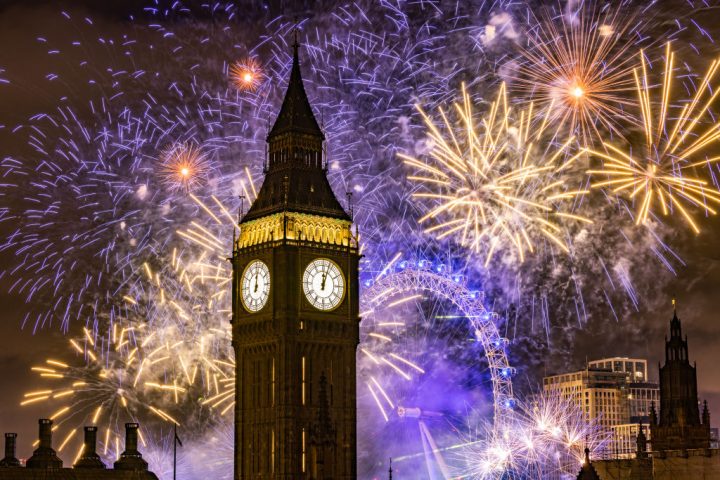One test of great architecture is whether it, and the city it stands in, can be recognised from its silhouette alone. There is Spavento’s campanile – or bell tower – in Venice by St Marco’s Basilica and Giotto’s by the Duomo in Florence. London has a campanile too, perhaps more recognisable than its Italian precedents. Designed by Augustus Welby Northmore Pugin, the clock tower of Parliament houses the bell known as Big Ben. New Year’s Eve 2023 marks 100 years since its bongs were broadcast to the nation for the first time. A century on from that televised spectacle, the eery, throbbing noise of Big Ben remains one of the most familiar and evocative of sounds.
‘There! Out it boomed. First a warning, musical; then the hour irrevocable,’ wrote Virginia Woolf in Mrs Dalloway. Big Ben’s quarter-hour chimes are based on a 1793 tune called ‘Westminster Quarters’, itself sourced from Handel’s ‘I know that my Redeemer liveth’. The quarters are also used in Ottawa’s Peace Tower and the San Francisco ferry terminal. Bizarrely, this tune is also heard in many schools in China and Japan, signalling break time.
It was said that, because of the intensity with which he worked, Pugin lived sixty years in forty
Once heard, the irrevocable sound of the bell is hard to forget. So, too, is the design of the clock tower itself. Before Big Ben, ‘Great Peter’ in York was the nation’s largest bell. But for Parliament’s clock tower, the Whitechapel bell foundry cast a bell of an appropriately epic scale. Big Ben weighs 13,760 kilograms and is probably named after Sir Benjamin Hall, chief lord of the woods and forests, who supervised its installation, although an alternative belief is a popular prize-fighter of the day might have been the inspiration.
Whatever the origin of its name, this eternal symbol of London arose from a calamity: in 1834, Parliament was destroyed in a fire. The government stipulated that the replacement be ‘either Gothic or Elizabethan’. Weirdly, though, they chose Sir Charles Barry, an architect better known for classical, Italianate designs, including Manchester City Art Gallery and the Reform Club. Accordingly, Barry hired the medieval-leaning Augustus Pugin to help with the drawings and paid him £400.
Like Brunel, that other genius of Victorian iconography, Pugin’s father was French. He was the furious genius of the Gothic revival, infatuated with the moral grandeur of the Middle Ages which he wanted to recreate in industrial Britain through restless reinvention of its forms and motifs. In this way, he believed, society would be purified. Possibly even levelled-up. Ironically, his clock tower, so far from being medieval, looks like nothing quite so much as High Victoriana at its majestic, tumescent best.
In the middle of the 19th century, the only architectural punctuations of the skyline were buildings devoted to public or divine service: universities, hospitals, churches and asylums. At 96 metres tall, just St Paul’s and Westminster Abbey were taller than the clock tower when it was built, thereby putting parliamentarians only a few metres below God in the order of things.
Pugin’s design for the clock tower was trialled at Scarisbrick Hall near Liverpool, whose general arrangement it resembles, although Westminster’s decoration is far more lavish. The structure of Big Ben is brick, clad in limestone and the roof tiles are cast-iron. Recurrent motifs include national symbols of the Union: the Tudor rose, Welsh leek, Irish shamrock and Scottish thistle.
The workload involved with designing the clock tower and the fantastic decorative scheme for all Parliament’s interiors undermined Pugin’s already fragile health. The activity was incessant and his preoccupation with detail almost deranged: there are a good many archivolts, squints and spandrels in Parliament that required his attention to decorate. Yet, despite his astonishing achievement, Pugin was displeased with the result. He told an acquaintance: ‘All Grecian, sir; Tudor details on a classic body.’
It was said that, because of the intensity with which he worked, Pugin lived 60 years in 40. But, even before his messianic and insomniac devotion to work began to show itself, he was presenting peculiar quirks of character. It may have been mercury poisoning; Rosemary Hill, his biographer, speculates that the young Pugin could have caught syphilis while dallying with infected opera singers and actresses in Covent Garden. Hyperthyroidism is a more polite diagnosis.
He also had a lunatic fixation on the sea. ‘There is nothing worth living for but Christian architecture and a boat’ was a belief he always maintained. He often dressed as a sailor, but the art historian Kenneth Clark, in his early 1928 masterpiece The Gothic Revival, said Pugin had a ‘horror’ for the mariner’s diet of beer and tobacco. Contemporaries spoke of his ‘indescribable charm’. While he was socially reserved, Benjamin Ferrey, an early biographer, noted that ‘all who approached him felt they were in the presence of no ordinary man’.
From his home in Ramsgate in Kent, this far from ordinary man would, in all weathers, disappear suddenly out onto the North Sea in his flat-bottomed coble rowing boat to rescue sailors in difficulties on the Goodwin Sands. Towards the end of his frenetically creative career, he was troubled by hallucinations of shipwrecks. One account said he sweated so much that five or six changes of shirt were required daily. His doctors said he was ‘very dirty in his habits’; at one stage Pugin’s head was shaved to manage his soaring temperature. Towards the end of his life, there were spells in the Kensington Asylum and in Bethlem Royal Hospital in Southwark – better known as the notorious ‘Bedlam’, on the site of what is now the Imperial War Museum. He died at home in Ramsgate, aged that mere 40 years old, suffering convulsions, after bleeding by leeches had failed to control his deteriorating condition.
As we hear the bong tonight – somewhere between 199Hz and 336HZ – we can muse on what Churchill said: ‘We shape our buildings and afterwards our buildings shape us’. It may be irreverent to say so, but how strange that members of the ‘mother of parliaments’ sit in a building which is a personal vision of a psychotic syphilitic, given to wild delusions and weird hallucinations.
Wren’s memorial in St Paul’s says ‘If you seek his monument, look around’. If you want to recollect Pugin’s monument, listen for those bongs on Radio 4 that sound before the six o’clock news and at midnight. It’s a sound that excites a memory of that ineffable silhouette: London’s campanile, a profile of genius.






Comments